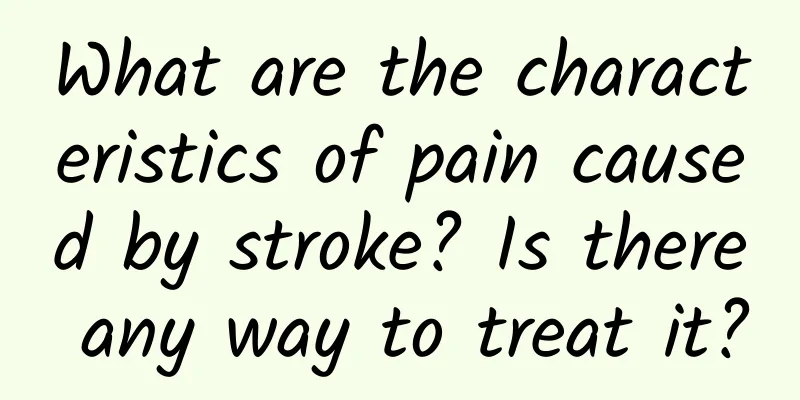What are the characteristics of pain caused by stroke? Is there any way to treat it?

|
Author: Hu Yongsheng, Chief Physician, Xuanwu Hospital, Capital Medical University Reviewer: Xing Yan, Chief Physician of Aviation General Hospital There are two types of stroke: cerebral infarction, which is an ischemic stroke; and cerebral hemorrhage, which is a hemorrhagic stroke. The pain caused by these two types of stroke is called post-stroke pain. 1. Will all people experience post-stroke pain after a stroke? Not all strokes cause post-stroke pain. This is often related to the location of the stroke. The location of the lesion determines whether pain is likely to occur. A small infarction, about one millimeter or two millimeters, or even smaller; a small amount of bleeding, three milliliters or five milliliters, but it occurs in a more sensitive location, is likely to cause post-stroke pain. For example, a right thalamic stroke can cause pain in the left half of the face, half of the body, including the trunk and limbs. There are also cases where pain is caused in half of the head and face, half of the trunk, or half of the limbs. The range of pain is often relatively large, not limited to a relatively small range. Figure 1 Original copyright image, no permission to reprint The most common site of post-stroke pain after a stroke is the thalamus. The thalamus is a very important nucleus that controls the body's sensations and movements. It is divided into the sensory thalamus and the motor thalamus. If the bleeding happens to be in the sensory thalamus, it doesn't need to be a large amount, just a little, or if there is an infarction in the sensory thalamus, post-stroke pain is likely to occur, which was previously clinically called thalamic pain. Figure 2 Original copyright image, no permission to reprint In addition to the thalamus, strokes in other areas, such as the medulla oblongata and cortex, are also prone to post-stroke pain. 2. What are the characteristics of pain after stroke? First, the pain is persistent, often present for 24 hours, and slowly worsens, becoming more and more severe over time. On this basis, there may be a period of paroxysmal attacks of severe pain. Second, the pain after a stroke is more of a burning pain, a scorching pain; another type of pain is a knife-like pain, a needle-like pain, and a squeezing pain. The time when pain occurs after a stroke is not very certain. It can occur at any time. Some people may experience pain immediately after the onset of the disease; some may experience pain several months, half a year, or even a year or two after the onset of the disease. Generally speaking, most people are more likely to experience pain three to six months after a stroke, and this period is the fastest recovery process after a stroke. For example, after a stroke, there will be hemiplegia and limb sensory impairment. Through drug treatment or rehabilitation treatment, the function will be restored, and pain will also appear in the recovery process. If there is no pain during this period, the chance of it occurring again in the future will be relatively small. 3. How to treat pain after stroke? The current view on the treatment of post-stroke pain is that once pain occurs, it should be treated promptly and not endured. Pain treatment will help the recovery of the stroke itself. And the earlier the treatment, the better the effect will be. Don't delay it until the end, otherwise it will be relatively difficult to treat. The simplest way to treat pain after a stroke is to take painkillers. There are many drugs to choose from, but generally speaking, the effects of drug treatment are not particularly ideal. The most fundamental reason lies in the location of the stroke. If the stroke problem in this area is not solved, the pain will be difficult to completely control. For patients who have just started to experience pain, early pain relief can reduce the impact of pain, alleviate the severity of pain, and prevent the disease from progressing so quickly. However, it is difficult for painkillers to completely control pain. As time goes by, the dosage used will increase, the side effects will increase, and the effect will become worse. If the pain is still not well controlled by medication, surgical treatment may be considered. At present, only surgical treatment can effectively control this post-stroke pain. There are two main types of surgical methods for treating post-stroke pain in clinical practice. One type is surgery to cut off nerve conduction and destroy nerve nuclei, which means cutting off the pain conduction pathway so that pain is not felt. Another type is neuromodulation surgery, which is a new method that places a neural pacemaker in the brain to control and inhibit the conduction and formation of pain, so that the patient does not feel pain, and also achieves the effect of pain relief. This is the method currently used and is also used internationally. It is more lasting, safer and less invasive than the first method of destroying nerves, and the treatment parameters can be adjusted as the disease progresses. |
<<: A few things you need to know about brain pacemaker treatment for Parkinson's disease!
>>: Don’t young people get Parkinson’s disease?
Recommend
How to regulate thin endometrium, diet therapy is effective
Dietary adjustments, Western medicine treatment, ...
What to eat to whiten and lighten spots
Fair and spotless skin is what every woman hopes ...
Reasons for itchy right nipple
I believe every woman has experienced itchy nippl...
What does wild roxburgh look like? How to eat wild roxburgh
Sea buckthorn fruit is also a kind of fruit. Dryi...
How do you know you've implanted?
After many couples get married, they want to have...
What are the dietary rules for the Xiaoxue solar term? What to eat during the Xiaoxue solar term is good for the body
The weather gets colder during the Xiaoxue solar ...
How to choose a guitar? Which country invented the guitar?
Guitar music has various styles and forms. Guitar...
Can I eat walnuts during menstruation?
Can you eat walnuts during menstruation? When it ...
What should women do if they keep having menstruation?
Menstruation is a normal physiological phenomenon...
Precautions for a small amount of amniotic fluid leakage
Women who have just become pregnant are very exci...
What are the symptoms of candidal vaginitis
The vagina is the garden of a woman's health ...
Can I get pregnant with a urinary tract infection?
The so-called urinary tract infection refers to i...
What to do if the menstrual volume is small after curing the uterus
A uterine curettage operation is usually performe...
Itchy armpits during pregnancy
Women cannot take medicine or get injections duri...
Treatment for small and dark menstrual discharge two days before menstruation
The incidence of menstrual problems cannot be und...









